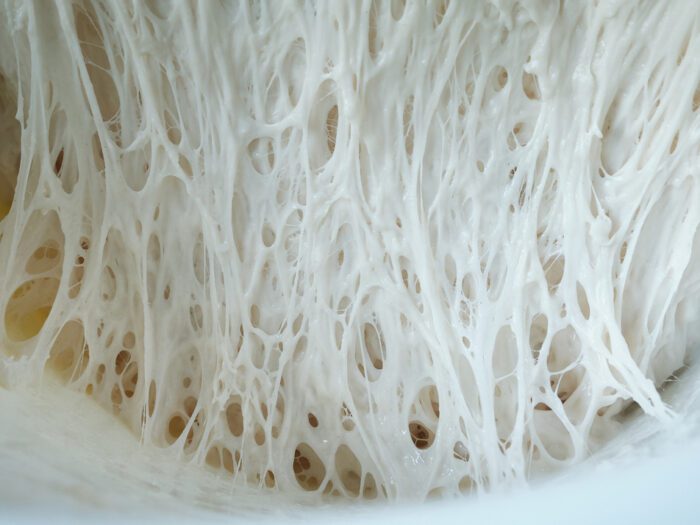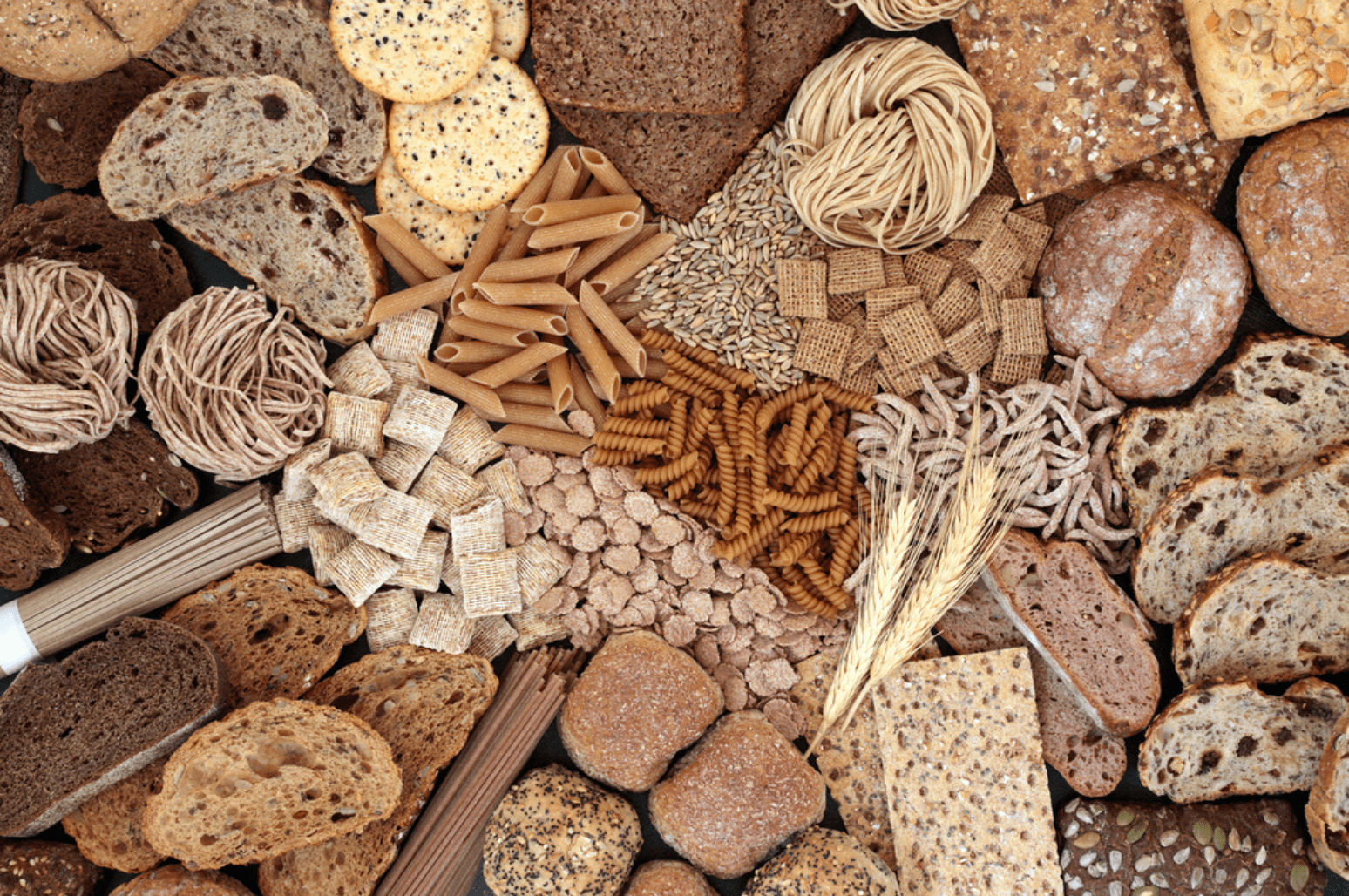
Gluten is discussed here, there, and everywhere. If you’re not going gluten-free, you probably know someone who is. Why is gluten harmful to some people? What’s the deal with gluten? Let’s delve into the details!
What Is Gluten?
Gluten refers to many different types of proteins (prolamins) in barley, wheat, rye, and triticale. The primarily prolamins in wheat are glutenin and gliadin, and the main prolamin in barley is hordein. [1]
Gluten proteins like glutenin have elastic properties, making them a preferred choice for baked goods. Some manufacturers add extra gluten to food products to increase the rise, strength, and shelf life.
Surprisingly, today Westerners on a modern diet consume around 5-20 grams of gluten per day. [2]
Protease enzymes in your digestive tract break down proteins. Gluten proteins are resistant to protease enzymes, so they aren’t digested properly, which can lead to larger molecules and units of amino acids crossing over through the intestinal walls and into the rest of your body. When these larger molecules cross through the intestinal walls into the body, it triggers immune responses that could be a causative factor in various gluten-related conditions, including Celiac disease.
Gluten Intolerance
Gluten intolerance is the umbrella term for three conditions: celiac disease, wheat allergy, and gluten sensitivity.
What Is a Wheat Allergy?
Wheat allergy is common in children and involves an abnormal immune response to certain proteins in wheat and wheat products.
After ingesting wheat or wheat flour, symptoms of a wheat allergy include nausea, skin reactions, and even life-threatening anaphylaxis–an allergic reaction resulting in a narrowing of the airways and breathing difficulty.
Celiac disease and wheat allergy are different, but it’s possible for someone to have both conditions. Wheat allergies are often diagnosed by allergists using skin-prick or blood testing.

What Is Celiac Disease?
Celiac disease is a serious inflammatory autoimmune condition caused by environmental and genetic factors. It’s estimated to impact around 1% of the global population. The prevalence of celiac disease is higher, around 2-5% in countries like Mexico, Finland, and areas of North Africa. [3] [4] [5]
Celiac disease involves many bodily systems, but it’s mostly considered an inflammatory condition of the small intestine. Eating these grains damages the cells lining the small intestine (enterocytes) in those with celiac disease leading to weight loss, diarrhea, and nutrient malabsorption. [6]
Celiac disease can cause other symptoms like anemia, dermatitis, and neurological problems. The condition is typically diagnosed by intestinal biopsy or blood testing for specific antibodies or genotypes. People with celiac disease should avoid gluten at all times. [7]
What Is Non-Celiac Gluten Sensitivity?
If someone without a wheat allergy or celiac disease consumes gluten and experiences symptoms like headache, joint pain, and fatigue, they might be diagnosed with non-celiac gluten sensitivity (NCGS). [8]
The doctor typically first rules out wheat allergy and celiac disease to diagnose NCGS since the symptoms overlap. People with NCGS report significant symptom improvement when following a gluten-free diet.
Gluten and Autoimmune Disease

Celiac disease is actually more prevalent in those with other autoimmune conditions. [9] Studies show a gluten-free diet is effective in decreasing symptoms related to several conditions, including autoimmune disease and irritable bowel syndrome.
Researchers theorize gluten might cause or worsen autoimmune conditions like type 1 diabetes, rheumatoid arthritis, Hashimoto’s thyroiditis, and Grave’s disease.
Studies show a gluten-free diet benefits people with various autoimmune diseases. [10] Autoimmune diseases share common immune pathways and genes with celiac disease. Molecular mimicry is one of the ways gluten could exacerbate autoimmune conditions. With molecular mimicry, certain molecules found in foods are similar in molecular structure to your body’s own antigens. When you eat the food, your body invokes an immune response to the food and your own antigens. In other words, your body produces antibodies that react with both the ingested antigen (the molecules in the food) and your body’s own tissues. [11] [12]
IBS and Other Health Conditions
Gluten has also been associated with other conditions like ulcerative colitis, Crohn’s disease, and irritable bowel syndrome (IBS). [13]
In people with IBS and IBD, gluten has been found to change the gut bacteria and increase intestinal permeability (loss of integrity of the junctions in the intestinal lining). [14]
Gluten-free diets can benefit people with other conditions, such as fibromyalgia, schizophrenia, and endometriosis.
Going Gluten-Free on Keto
Some researchers and health professionals advocate a more ancestral eating approach and believe human digestive systems haven’t evolved to digest the amount or type of grain proteins common in today’s modern diets. They also point to the possible detrimental consequences and overuse of agricultural pesticides.

It could be a bit more complicated than just gluten. Studies show other molecules in wheat could be a problem and worsen or trigger non-celiac gluten sensitivity (NCGS), such as FODMAPs (BLA), wheat germ agglutinins, and amylase trypsin inhibitors. Research on gluten and overall health is fascinating and ongoing. [15]
Cutting out gluten typically means limiting processed and refined foods. Gluten-containing foods are often high in sugar, unhealthy fats, and unnatural additives and preservatives. You’re likely to feel better switching out gluten-containing foods with healthier choices like veggies, good fats, protein, nuts, and seeds. As long as you’re consuming nutritious foods and a balanced diet, kicking gluten to the curb is completely safe! Remember, just because a product is labeled gluten-free doesn’t mean it’s healthy!
More and more people are going gluten-free for lots of reasons. Some people have celiac disease, so it’s a necessity, and others just claim they feel better and experience less joint pain and fatigue when ditching gluten. Others have an autoimmune disease and follow a specific therapeutic gluten-free protocol.
You won’t know how you feel going gluten-free until you try, so it might be worth a shot, particularly if you’re dealing with a health problem. Check out our user-friendly beginner’s guide to gluten-free keto! It’s always best to visit your doctor or healthcare practitioner before changing your diet.
Thankfully, it’s getting progressively easier to go gluten-free and more options and products are commercially available on the market than ever before.
References
Niland, B., & Cash, B. D. (2018). Health benefits and adverse effects of a gluten-free diet in non-celiac disease patients. Gastroenterol Hepatol, 14(2), 82-91.
Biesiekierski, J. R. (2017). What is gluten? J Gastroenterol Hepatol, DOI: 10.1111/jgh.13703
Balakireva, A. V., & Zamyatnin, A. A. Jr. (2016). Properties of gluten intolerance: Gluten structure, evolution, pathogenicity, and detoxification capabilities. Nutrients, 8(10), 644. DOI: 10.3390/nu8100644
Parzanese, I., Qehajaj, D., Patrinicola, F., Aralica, M., Chiriva-Internati, M., Stifter, S., Elli, L., & Grizzi, F. (2017). Celiac disease: From pathophysiology to treatment. World J Gastrointest Pathophysiol, 8(2), 27-38. DOI: 10.4291/wjgp.v8.i2.27
Reilly, N. R., & Green, P. H. R. (2012). Epidemiology and clinical presentations of celiac disease. Semin Immunopathol, 34(4), 473-8. DOI: 10.1007/s00281-012-0311-2
Posner, E. W., & Haseeb, M. (2021). Celiac Disease. Stat Pearls Publishing. Celiac Disease - StatPearls - NCBI Bookshelf (nih.gov)
Lewis, D., Haridy, J., & Newnham, E. D. (2017). Testing for coeliac disease. Aust Prescr, 40(3), 105-108. DOI: 10.18773/austprescr.2017.029
Leonard, M. M., Sapone, A., Catassi, C., & Fasano, A. (2017). Celiac disease and nonceliac gluten sensitivity: A review. JAMA, 318(7), 647-656. DOI: 10.1001/jama.2017.9730
Bibbo, S., Pes, G. M., Usai-Satta, P., Salis, R., Soro, S., Colosso, B. M. Q., & Dore, M. P. (2017). Chronic autoimmune disorders are increased in coeliac disease. Medicine (Baltimore), 96(47), e8562. DOI: 10.1097/MD.0000000000008562
Lerner, A., Shoenfeld, Y., & Matthias, T. (2017). Adverse effects of gluten ingestion and advantages of gluten withdrawal in nonceliac autoimmune disease. Nutr Rev, DOI: 10.1093/nutrit/nux054
Cusick, M. F., Libbey, J. E., & Fujinami, R. S. (2012). Molecular mimicry as a mechanism of autoimmune disease. Clin Rev Allergy Immunol, 42(1), 102-11. DOI: 10.1007/s12016-011-8294-7
Vojdani, A. (2015). Molecular mimicry as a mechanism for food immune reactivities and autoimmunity. Altern Ther Health Med.
Aziz, I., Branchi, F., Pearson, K., Priest, J., & Sanders, D. S. (2015). A study evaluating the bidirectional relationship between inflammatory bowel disease and self-reported non-celiac gluten sensitivity. Inflamm Bowel Dis, DOI: 10.1097/MIB.0000000000000335
Vanuytstel, T., Vermeire, S., & Cleynen, I. (2013). The role of haptoglobin and its related protein, Zonulin, in inflammatory bowel disease. Tissue Barriers, 1(5), e27321. DOI: 10.4161/tisb.27321
Aziz, I., Dwivedi, K., & Sanders, D. S. (2016). From coeliac disease to noncoeliac gluten sensitivity; should everyone be gluten free? Curr Opin Gastroenterol, 32(2), 120-7. DOI: 10.1097/MOG.0000000000000248










